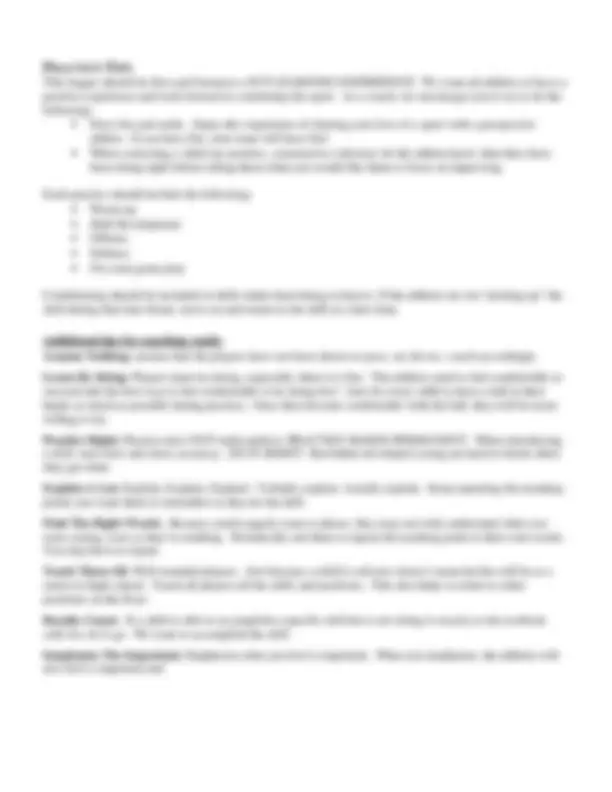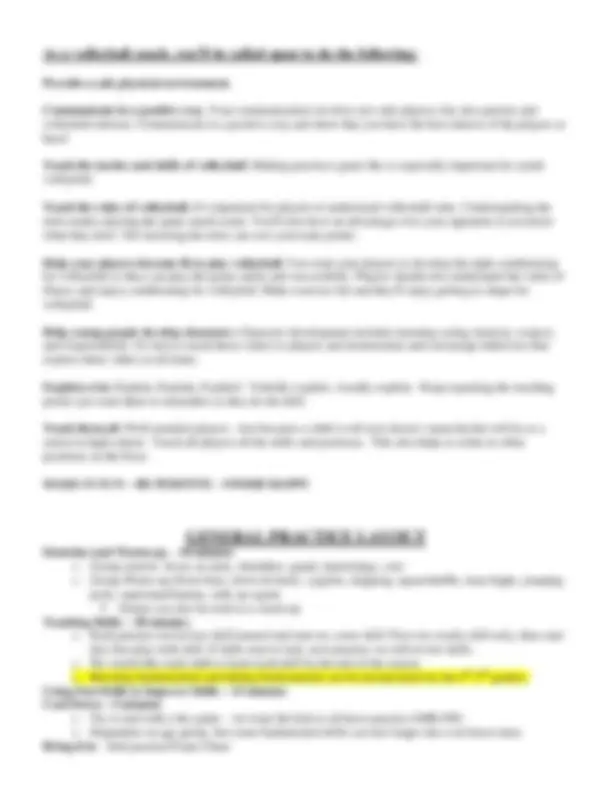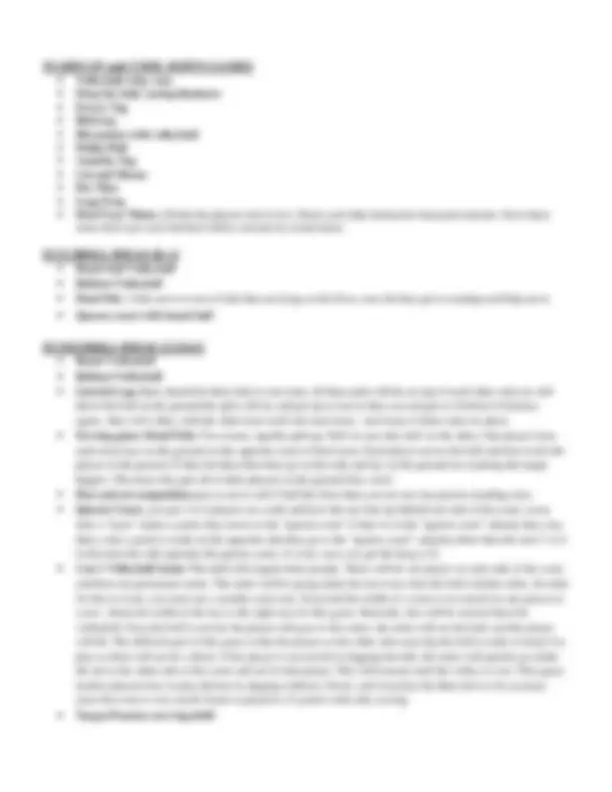





Study with the several resources on Docsity

Earn points by helping other students or get them with a premium plan


Prepare for your exams
Study with the several resources on Docsity

Earn points to download
Earn points by helping other students or get them with a premium plan
Community
Ask the community for help and clear up your study doubts
Discover the best universities in your country according to Docsity users
Free resources
Download our free guides on studying techniques, anxiety management strategies, and thesis advice from Docsity tutors
A comprehensive list of volleyball fundamentals, including skills, rules, and drills for coaches and players. It covers various aspects of the game, such as hitting, blocking, passing, serving, and court positions. The document also includes tips for coaching youth volleyball and suggestions for warm-up and cool-down games.
Typology: Exams
1 / 5

This page cannot be seen from the preview
Don't miss anything!




The following is a list of basic fundamental volleyball skills. The goal is for all participating athletes to establish the same fundamental skills as their teammate. However, remember that children all learn and develop at different rates and no child should ever be criticized for not picking-up a skill as quickly as their peers. The plan should be used as a guideline for putting together practice outlines and for teaching the ‘know-how’ of the game of volleyball. It is essential to the overall success of PAC’s youth volleyball program that all coaches aim to teach the fundamentals and sport knowledge.
Game Knowledge The Court How to Score Rules on Touches (3 and over) Court Positions Court Communication
Terminology Ace - A serve that is not passable and results immediately in a point. Antenna - The vertical rods (normally white and red) mounted near the edges of the net. The antennas are mounted directly above the sidelines and are not-in-play. Antennas are not usually used on outdoor nets. Approach - Fast stride toward the net by a spiker before he jumps in the air. Attack - The offensive action of hitting the ball. The attempt by one team to terminate the play by hitting the ball to the floor on the opponent's side. Attack Line - A line 3m from the net that separates the front row players from the back row players. Commonly referred to as the "10-foot line." Backcourt - The area from the end line to the attack line. Block - A defensive play by one or more players meant to deflect a spiked ball back to the hitter’s court. It may be a combination of one, two or three players jumping in front of the opposing spiker and contacting the spiked ball with the hands. Bump – a common term for forearm passing. Center Line - The boundary that runs directly under the net and divides the court into two equal halves. Dig - Passing a spiked or rapidly hit ball. Slang for the art of passing an attacked ball close to the floor. Forearm Pass - Join your arms from the elbows to the wrists and strike the ball with the fleshy part of your forearms in an underhand motion. Free Ball - A ball that will be returned by a pass rather than a spike. This is usually called aloud by the defense instructing players to move into serve receive positions. Hit - To jump and strike the ball with an overhand, forceful shot. Hitter - Also "spiker" Kill - An attack that results in an immediate point or side out. Line - The marks that serve as boundaries of a court. Overhand Serve - Serving the ball and striking it with the hand above the shoulder. Pepper - A warm-up drill in which two players pass, set, and hit the ball back and forth. Rally - The exchange of plays that decides each point. Rally Point - A point is recorded for every single rally no matter who is serving. Unforced errors or missed serves also results in a point for the other team. Ready Position (defensive stance) - The flexed, yet comfortable, posture a player assumes before moving to contact the ball. Rotation - The clockwise movement of players around the court and through the serving position following a side out. Serve - One of the six basic skills; used to put the ball into play. It is the only skill controlled exclusively by one player.
Server - The player who puts the ball into play. Service Winner - A point the serving team scores when this player has served the ball. The point can be an immediate (in the case of an ace) or delayed (a kill or opponent attack error after a long rally). Therefore, the sum of the team's service winners equals their score. Set - The tactical skill in which a ball is directed to a point where a player can spike it into the opponent's court. Setter – the player who has the 2nd of 3 contacts of the ball who "sets" the ball with an "Overhand Pass" for a teammate to hit. The setter normally runs the offense. Shank - When a player unintentionally passes a ball in a wild manner, rendering it unplayable to his or her teammates. Spike - Also hit or attack. A ball contacted with force by a player on the offensive team who intends to terminate the ball on the opponent's floor or off the opponent's blocker. Tip – A ball that is pushed or directed with force by an attacking team. Touch –contacts by a player. Transition - The change from defense to offense, or vice versa.
Rules Carry - misplayed ball involving "prolonged contact;" also called a lift or throw. Double Touch - Excessive touches or contacts by the same player. (Illegal) Foot Fault - The penalty incurred when the server's foot touches the playing surface, including the baseline, before contacting the ball, or any other player's foot touches the opposing court. Net Fault - An illegal act whereby a player touches the net while the ball is in play. It is not a fault if the contact was caused by the ball's forcing the net into the player's hand or body, or if it was accidentally caused by a player not playing the ball, also known as netting. Net Serve - A serve that hits the net; it is a fault if the ball does not continue across into the opponents' court. Service Error - An unsuccessful serve in which one or more of the following occurs: 1) the ball hits the net or fails to clear the net, 2) the ball lands out of bounds, or 3) the server commits a foot fault. Side Out - Occurs when the receiving team successfully puts the ball away against the serving team, or when the serving team commits an unforced error, and the receiving team thus gains the right to serve. Blocking – Only front row is allowed to block
Court Positions Hitter - Most often attacks the balls which setter sets most often close to the net. Blocker - Main responsibility is to stop the opponent’s offense. Setter - Main responsibility is to set up the hitters--wherever they may be (this could even mean back row). The second contact of each possession is meant for the setter. Front Row Players - Players who are allowed to block the opponent and attack the ball in the attack zone. Back Row Players - Players who play defense by digging opponent’s attacks and attack the ball behind attack line (3 meter line, 10 feet line).
Provide a safe physical environment.
Communicate in a positive way. Your communication involves not only players, but also parents and volleyball referees. Communicate in a positive way and show that you have the best interest of the players at heart.
Teach the tactics and skills of volleyball. Making practices game like is especially important for youth volleyball.
Teach the rules of volleyball. It's important for players to understand volleyball rules. Understanding the rules makes playing the game much easier. You'll also have an advantage over your opponent if you know what they don't. Not knowing the rules can cost your team points.
Help your players become fit to play volleyball. You want your players to develop the right conditioning for volleyball so they can play the game safely and successfully. Players should also understand the value of fitness and enjoy conditioning for volleyball. Make exercise fun and they'll enjoy getting in shape for volleyball.
Help young people develop character. Character development includes learning caring, honesty, respect, and responsibility. It's best to teach these values to players and demonstrate and encourage behaviors that express these values at all times.
Explain a lot. Explain, Explain, Explain! Verbally explain, visually explain. Keep repeating the teaching points you want them to remember as they do the drill.
Teach them all. Well-rounded players. Just because a child is tall now doesn’t mean he/she will be as a senior in high school. Teach all players all the skills and positions. This also helps to relate to other positions on the floor.
MAKE IT FUN – BE POSITIVE – FINISH HAPPY
Stretches and Warm-up – 10 minutes o Group stretch– focus on arms, shoulders, quads, hamstrings, core o Group Warm-up (form lines: down & back)– jog/run, skipping, squat/shuffle, knee highs, jumping jacks, superman/banana, sally up squats Games can also be used as a warm up Teaching Skills – 30 minutes o Each practice revisit last skill learned and start on a new skill. First two weeks skill only, then start into free play with skill. If skills start to lack, next practice we will revisit skills. o We would like each child to learn each skill by the end of the season o Blocking fundamentals and hitting fundamentals can be incorporated for the 4 th^ -5th^ graders. Using Fun Drills to Improve Skills – 15 minutes Cool Down – 5 minutes o Try to end with a fun game – we want the kids to all leave practice SMILING o Dependent on age group, but some fundamental drills can last longer into cool down time. Bring it in – End practice/Team Cheer
WARM-UP and COOL DOWN GAMES
FUN DRILL IDEAS (K-1)